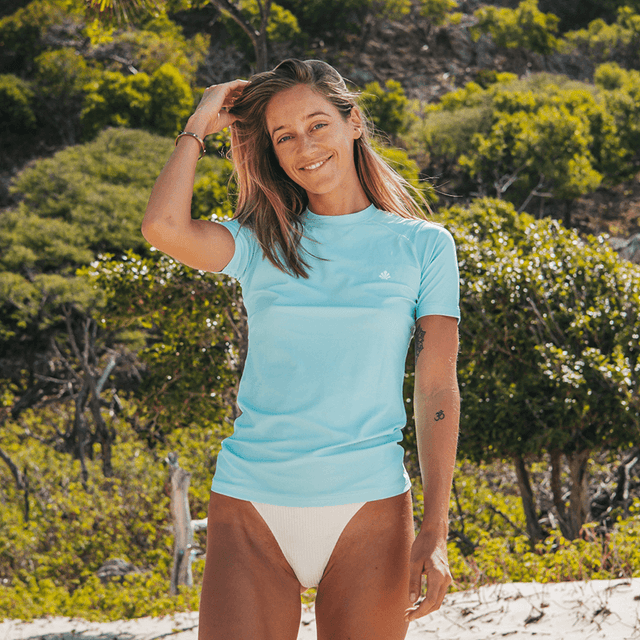HEALTH - FOR SUMMER SURFING, OPT FOR GOOD SUN CREAM
Whether in summer or all year round, surfers are among the people most exposed to the sun's rays. It's important to understand that water reflects between 10% and 30% of UV radiation, while sand reflects between 5% and 25%. Without effective protection such as sunscreen, you'll quickly expose yourself to sunburn and, in the long term, to the risk of skin cancer and premature aging. An awareness that should encourage you to take good care of your skin when enjoying the sun.
For surfers who spend long hours in the water, exposure to UV rays is significant. Fortunately, there are three solutions for maximum protection:
1. Opt for appropriate clothing, such as a neoprene or lycra wetsuit, to cover a large part of your body and protect it.
2. Wear headgear such as a cap to provide maximum protection for your head and face.

3. Apply sunscreen (this is a MANDATORY step) to areas not protected by your outfit, such as your face, feet and hands. Pay particular attention to your face, using a suitable product.
The importance of choosing an good sunscreen
You can find a wide range of sun creams, of all brands. However, as a board sports enthusiast, it's crucial to understand the impact these products have on our environment.
But before choosing your sun cream, it's important to understand why you're protecting yourself. Did you know that there are several classes of UV rays?
Yes, when you go out in the sun, you expose your skin to 3 types of UV:
- UVC, which is stopped by the ozone layer.
- UVB, which has an immediate effect. When you get a sunburn or a burn, this is due to overexposure of your skin to UVB rays.
- UVA rays, which have a long-term effect and are responsible for skin ageing.
Don't forget that you're constantly exposing your skin to UV rays, even when it's cold and cloudy, so remember to protect yourself every day.
We invite you to consult the Seventy One Percent white paper to find out more.
Your choice of sun cream therefore plays a major role not only for your skin, but also in your impact on the environment, as so-called ‘classic’ sun creams dump over 25,000 tonnes of active chemicals into our oceans. Fortunately, some brands, such as Seventy One Percent, have taken the eco-responsibility route by developing suncare ranges that are healthier for you and the planet.
The composition
These days, European regulations require the marketing of sunscreens that protect against UVA and UVB rays, but there is no obligation regarding their environmental impact, so we advise you to choose a brand that is transparent and sensitive to its impact.
Unlike "classic" sunscreens, which contain chemical filters, thickeners, preservatives, etc., environmentally-friendly sun creams are made from mineral filters: they favor the use of vitamin E, glycerine, vegetable oils and/or essential oils. You may be wondering what the major differences are between these two filters, so we'll explain:
- organic filters, which absorb UV rays and diffuse them in the form of heat, are bad for your health and the environment.
- mineral filters are good for your skin and the environment because they absorb, reflect and diffuse UV rays.
The efficiency
If you go environmentally-friendly sun creams, you'll be just as well protected! Sun protection indices are subject to very strict European standards.
It's not always easy to choose the right sun cream for your needs, so Seventy One Percent advises you to consider two factors:
- Your skin phototype: the fairer your skin, the higher the protection you'll need.
- The UV index to which you'll be exposed: the higher the index, the higher the protection you'll need.
As a minimum, opt for SPF30 with high protection.
By opting for a good sun cream, you protect your skin while preserving the beauty of the oceans and the natural world around us. A responsible and conscious approach that helps preserve our environment for future generations.
The choice of a ‘made in France’ brand
We'd like to introduce you to Seventy One Percent products, a brand created (in 2009) by surfers for surfers. Seventy One Percent focuses on the effectiveness of the product promise and the quality of the formulation to combine performance, respect for consumers and respect for the planet. It's only natural that we should introduce you to this made in France brand, which shares the values of Saint Jacques.
A transparent, committed cosmetics brand with a different ambition to the others: products made in France that perfectly meet their specific needs as surfers and who respect their bodies and the environment with "Very water resistant" sun creams that dissolve less in water for greater effectiveness and respect for our oceans.
The perfect product doesn't exist, but sun protection is essential, so you can choose a brand that offers a pleasant formulation, reduces its packaging, is committed and transparent. And we've found all that in Seventy One Percent products.
Before each session, apply the appropriate sun cream and put on a lycra suit to protect your skin. You'll be well protected against UV rays.





1 Comment
O top